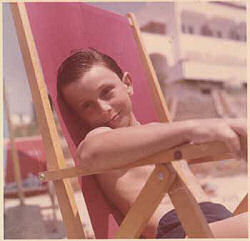
Paco Dècina was born in Naples on the Chiaja overlooking Mount Vesuvius and Capri. Although his studies were scientific, he discovered dance when he met the American choreographer, Bob Curtis who introduced Afro-Cuban techniques to him. In Rome he studied classical and contemporary dance with choreographer Vittori Biagi through American techniques. He very rapidly joined other dance Companies and went on to Paris in 1984. He became a dance teacher two years later at the local Conservatory in Champigny-sur-Marne where he began yet another life… He founded the Post-Retroguardia Company in 1986 and won the prize of "Chorégraphie de la Ménagerie de Verre" with Tempi morti, a nostalgic and nonchalant piece created for five dancers (Milan 1987).
Circumvesuviana,the name of a train servicing the villages located at the foot of Mount Vesuvius, was presented in February 1988 at the Théâtre d'Ivry, bringing national acclaim to Paco Decina. Through its slowness and interrogations regarding frontiers, this work brings forth a sacred yet profane imagery, qualities possessed by the people of the South. Intangible, imperceptible, Utopian – Scilla e Cariddi (TGP, 1990) marks a deciding point. Engaging the Company in a tormented yet intimate passage through the Detroit of Messine, Paco Decina went on to portray the body to imagery on stage. Vestigia di un corpo shows engulfed bodies by Scilla e Cariddi cutting itself to pieces with the memory of a recent barbaric act. Created in Quimper in September, 1991 this piece is like an invitation to a voyage to the end of the night, "where silently stratum, put to shape is aroused, the body's story and memory, the souvenir of the threatening shadows of a totalitarian, social body".
This Mediterranean languor, discreetly sensual, which seeps and dwells in the hollowness of the body comes to life in Ombre in rosso antico, first performed in Ocotober 1989 at the Centre d'art contemporain in Carré Saint-Vincent in Orléans. In these first three works one can notice "a clear penchant for the reverie which leans gesture to patterns or postures representing Byzantine Mosaics; the suspended bodies swaying from the animated to the inanimate like a testament to our memory, our daily life and symbols". Once interviewed on the role of a dancer, Paco Decina stated, "Dance has a social duty; the theatre is one of the last places where, through a performance one takes the time to get closer to one's self; it is a privileged moment of reflection on how one should be in the present. The audience must find a part of his own story in what he sees. Otherwise it's just a dance which is offensive to the being deep within the viewer".
Like challenging our very own renunciations Ciro Esposito fu Vincenzo (Orleans, January 1993), revived at the Théâtre de la Bastille and at the Théâtre de la Ville in Paris, a poetic meditation on death, revived during the residency in Vierzon at the Danses au Centre, renews with a secret dance of "tumultuous desire and radiant sensitivity".
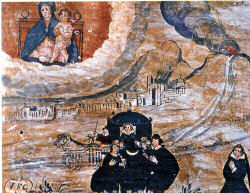
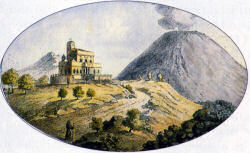
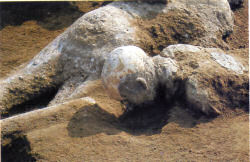
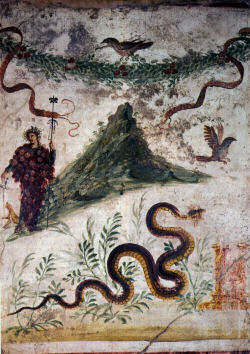
Following an artistic approach close to the Italian Anachronisms…dance strives to "speak a language which is disappearing more and more", to arouse yet another form of visibility. For Paco Decina « a dancer's work makes sense only if it touches the subconscious, if it allows the body's secret memory to surge. Fessure is performed as a preview in July 1994 at the International Festival of Dance in Aix-en-Provence: "these fissures are solos, duets, trios and small ensembles, which, like waves, embrace each other, intertwine and overlap until they tell us of yet another, bigger sea, an ocean hidden behind walls, walls of every day, walls of a distracted eye". In the same year he created Il Banchetto di sabbia for the ballet of Maggio Danza during the 57th Maggio Fiorentino (Florence) and Ottobre in chiaro e oscuro for The Academy Paolo-Grassi in Milan.
He directed Verdi's Macbeth in 1995 for the Teatro comunale de Florence directed by James Conlon – and began preparation for Mare rubato, created at the TNDI in Châteauvallon and revived at the Théâtre de la Ville in Paris in May 1996. (1) Invited to South Korea in October 1996 he performed Sinawui 2000, which he presented with Hyonok Kim during Séoul's International Dance Festival. In residency at the Cultural Forum of Blanc Mesnil in November 1996, Paco Dècina directed Le Marin by Fernano Pessoa – both a theatrical and chorographical experience – and then organized 3 Tributes for Christian Ferry-Tschaeglé, the music supervisor at the Théâtre de la Bastille who passed away on February 27, 1996. All of the artistes he represented were invited: Catherine Diverrès, Carlotta Ikeda, Francesca Lattuada and Jean-Marc Zelver, Regina Martino, Bernardo Montet, Caterina Sagna, Shakunthala and Lee Yanor. Paco Dècina created the solo, Infini at this tribute.
At the Cultural Forum of Blanc Mesnil in October 1997, he created Cinq passages dans l'ombre or Trasparenze to a scenography by Lee Yanor. Choreography with timeless direction as an explanation and of "sensitivity" where land surveying of the pre-conscious at the threshold of perception and memory, which Rosita Boisseau, dance critic for the French daily newspaper, Le Monde, acclaimed as the paradox of the choreography of immobility. (2) From Cinq passages dans l'ombre or Trasparenze, Dècina took Veli, a short piece for which he won the Prix d'auteur du Conseil général at the 6ème Rencontres chorégraphiques internationales de Seine-Saint-Denis. During the summer of 1998 at the Pavullo Festival in Italy upon the invitation from American choreographer, Teri Weikel, he wrote a new solo piece, Lettre au silence, offered as a visible crossing of weightlessness or as a glass of eternity in the temporal flow. He performed this piece at the Festival des Brigittines in Brussels and then at the Centre Beaubourg in Paris.
Huà, un homme vivant face à un homme mort, piece for six dancers, was created on January 29 and 30, 1999 at the Cultural forum of Blanc Mesnil. It questions the theme of metamorphosis and "the body as a sign of what is unthought-of of in movement". Immense scenes with spatial density and plastic beauty close to dreamlike texture and matter are "inter-composed" to a drama- like background with tiny but inescapable variations giving it all a certain meaning and an unreal atmosphere.»During a performance of Huà at the Comédie de Clermont-Ferrand, daily newspaper, La Montagne, suggested that "…Paco Decina's work holds together just as much by the stubborn refusal of demonstration as his insistence to write about the absence of pretension before our very own presence in this world… The body language is infinite so long as it frees us of signs and it's instructive limitations".
During the winter of 2000 at the Cultural Forum of Blanc-Mesnil and then at the residency at the Centre national chorégraphique in Rennes, he rehearsed Neti-Neti, (Neither here nor there), piece for two dancers, conceived as an overture to the silenced inner landscapes of our being. Ièna Fillberti wrote, "with a fleshful and fluid dance, the choreographer arrives at an utterly refined and uncluttered simplicity. (…) Searching for a neutral space where tensions are untied, Paco Decina realizes an architecture of the body whose qualities pacify the heart". This work was created in Porto, Portugal on April 8, 2000 and performed by Valeria Apicella and Paolo Rudelli.
Invited for the third time in Florence, Italy, he created for the Maggio Danza's cœur de ballet, a choreography based on Franco Battiato's original score. Campi Magnetici, created June 17, 2000 for the 63rd Maggio Musicale Fiorentino, at the Theatro Della Pergola. The costumes were signed Ragina Martino, the lights Christian Pinaud.
A piece for four dancers, Summa Iru was created in Dieppe on May 10, 2001. This is a "drama machine to capture and "bring the movement up" to its source, where from abandonment dance can be born", said the choreographer. The quartet's title suggests an initiation formula that would mean "relax, there's nothing to do", in the Tamil language (South of India).About Lettre au Silence, Neti-Neti and Summa Iru, Rosita Boisseau writes in the French magazine Telerama : "we can feel the (impalpable) mystery of a dance lived as a spiritual experience, and the evidence a simply beautiful movement, perfectly fit to the body that is interpreting it. The choreographer Paco Dècina, keen on Chinese medicine and oriental philosophy, shows with magic the rare articulation between soul (…) and flesh, all with a disturbing simplicity: a sort of essence of the dance, concentrated in 20 years of intensive examination of the movement, all the way to the most underground ramifications". (3)
From 6th to to the 21st of February 2002, with the support of the association AFAA and the French Embassy (French Alliance), the Company performs an Indian tour.Bangalore, Bombay/Mum bay, ands Chandigarh are the three destinations where Lettre au silence and Neti-Neti are performed. In Bangalore, the shows are programmed during the Attakkalari Festival (2nd International Festival Of movement Arts – Bangalore Biennal), and in Bombay, Paco Dècina opens up his classes to everyone, which is a major success. The public and the critic's reaction, warm and intrigued, the meetings with young enthusiastic Indian artists transform this tour into a special experience for the Company.
Back in France, Paco Dècina repeats a new solo.Non era giorno, non era notte (it is not day, it is not night) was created on March 26 and 27, 2002, at the Espace des Arts, in Chalon-sur-Saône, France. With a mastered gesture, a continuous and well-danced movement, "shadow and light is transcended by the dancer's magical appearances", the Italian critics write when he came to the Festival Danza Estate in Bergame in July 2002.
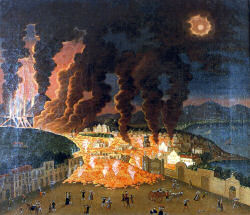
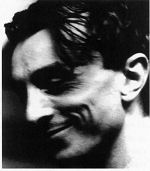
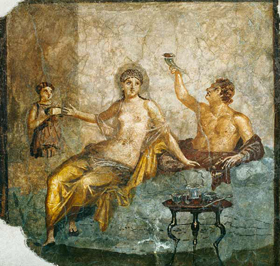
In September 2002, the Company is extended and two new dancers are welcome. Paco Dècina is preparing Soffio, a six-dancer choreography, created at the Paul-Eluard Theater on January 30th and February 1st 2003. Soffio (breath) is then played on March 11th 2003 at the Trident de Cherbourg-Octeville and on April 18th at the Comédie de Clermont-Ferrand, national stages that helped producing it. Soffio will be replayed at the Théâtre de la Cité Internationale in Paris on January 23 and 26 2004, then in tour around France and abroad.
For spring 2003, the Company is invited in Central Africa, with AFAA's support, where Lettre au Silence and Neti-Neti are presented in Gabon, Republic Democratic of Congo, Cameroun and Congo Brazzaville. During this trip, a training course is organized in Brazzaville with dancers coming from all over Central Africa. Complicities were made. The Company was offered to come back in September 2003 in Brazzavile and repeat the experience. The opportunity also for the Company to work on 2004's new creation, two duets called Intervalle. Created in Falaise (Calvados) on May 11th 2004, then presented in Artigues –near Bordeaux- and at the Centre Chorégraphique National in Nantes, Intervalle add to the Company's repertoire. In October 2004, Intervalle is presented to the Komedie Theater in Prague, after the Tczeck dancers took a training course under Paco Dècina.
The French Embassy of Costa Rica, has invited Paco Dècina to work on Soffio's remake with the dancers of the Atelier National of San José. This version of Soffio was presented for the opening night of the Festival de las Artes (Teatro la Aduana San José) in November 22nd 2004. When he came back, he finished Cherchant l'inspiration poétique, a piece created for the Music and Dance National Superieur Conservatoire of Paris's Junior Ballet, presented first in Paris in December 2004 then during a tour.
In September 2005, Paco Dècina created in Prague Salto Nel Vuoto, a piece for 5 dancers, Tcheque and Slovaque, played also in Bratislava in November 2005. In between, the Company presents Soffio during a tour in Central America (Honduras, Costa Rica, El Salvador, Panama, Guatemala and Nicaragua).
Starting in November 2005, Paco Dècina starts a four-year residency at the Théâtre de la Cité Internationale in Paris. In May 2006 he creates Chevaliers sans armure, a duet with Valeria Apicella and, in February 2007, Indigo, a six-dancer piece.
The cultural work and artistic collaboration accomplished together with the Théâtre de la Cité Internationale up until October 2009 offered a singular and exemplary experience. It also resulted in a three weeks of performances of Fresque, femmes regardant à gauche (January, February 2009), a piece for seven dancers and which also allowed the Company to expand on its artistic relations.
Paco Decina and his recent team initiated a new residency in 2010, which lasted two years at the Théâtre de Chartres. The creation, Sotto Sopra a piece for seven dancers opened in April, 2010, and was followed by Non Finito in 2011.
For the Korrespondance Europe project coordinated by Marie Kinsky (Association SESTA in Prague), Paco Decina created Waiting, waiting for... the Night! (2010), with two German dancers The duet performed in Prague, Bratislava and Bremen, before going on to tour.
In 2011-2012, the national theater in Malakoff, Théâtre 71, and the Company Paco Decina began working together developing artistic activities open to the public, before opening of the upcoming May 2012 creation, Précipitations, a three act choreographic piece. It is a voyage through music, audiovisual and installments where each collaborator, Laurent Schneegans, Serge Meyer, and Fred Malle shared their environment with the choreographer in a very unique way. In 2012 the Théâtre 71 from Malakoff and Paco Dècina worked together on a new creation as well as other cultural activities for the entire season.
Throughout 2013, Paco Dècina was interested in sacred places, telluric networks, airwaves of shapes, geobiology and the impact that the natural and architectural organization of a site has on the human organism. He initiated an artistic project mixing voice and dance, in historical venues. Inspired by the famous legend, Arthur is a choreographic and musical piece where baroque music and contemporary dance meet. In collaboration with Sébastien Fournier, countertenor and the Association Sprezzatura, accompanied by Jay Elfenbein on viola de gamba as well as Fred Malle on contemporary music, the creation took place in Saint-André-de-Bâgé, a very beautiful church in the region of Ain in France. It will soon play in the Paris region at the Notre Dame d’Etampes church, in collaboration with the Théâtre de Brétigny-sur-Orge, setting up residency in the Essonne department for the 2013/2014 season.
At the same time, he asked for a research residency at the Ateliers des ailleurs2. Winner, he will leave for 4 months (From December 2013 to early April 2014) to the Crozet Islands (an archipelago of the French Southern and Antarctic Lands - www.Taaf.fr). Back he creates La douceur perméable de la rosée (The permeable sweetness of dew) which will be presented in early 2015 at a new annual residency at Theatre 71, Malakoff's national stage, then at the Hivernales d'Avignon, at the THV in Angers, at the Onyx in Saint-Herblain, and in autumn 2015 at the CND, as well as at the Ultra Dance Festival in La Réunion.
(1) Article published in TCD, 12th season 1995/1996 with Irèna Filiberti's quotes
(2) Rosita Boisseau, "Paco Dècina, the unmoving dancer's search for eternity", Le Monde February 28th 1998
(3) Rosita Boisseau, "Lettre au Silence, Neti-Neti, Summaru Iru", published in Telerama from November 24th to 30th 2001.